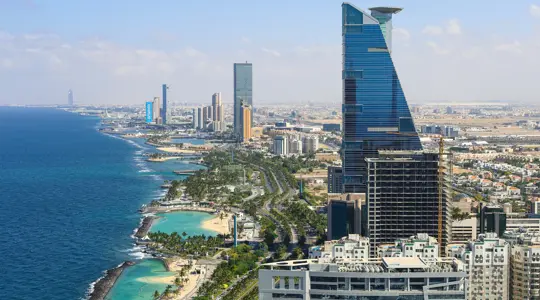Will Hejaz become the beating heart of Saudi Arabia’s nation building?
As Saudi Arabia accelerates towards its Vision 2030 goals, a practical question emerges: can the Kingdom’s western coast, not only support but lead the nation’s economic diversification and global positioning?
Stretching along the Red Sea, the Hejaz region is fast becoming a focal point for strategic investment in construction, transport and urban development. From religious tourism to advanced manufacturing, the scale of opportunity and transformation underway is extraordinary.
For the construction industry, this is not just a wave of projects, but a once-in-a-generation opportunity to shape the very foundations of a new economic geography.
A region under strategic focus
Vision 2030 is driving transformative investment across the west coast, positioning the region as an increasingly important contributor to national growth. Developments in Jeddah, Taif, Jazan, Makkah, Madinah and AlUla are reshaping urban landscapes, enhancing connectivity and positioning the region as a key engine of growth.
Religious tourism continues to be a primary driver.
With a target of 30 million Umrah pilgrims annually by 2030, the Kingdom has expanded the capacity of the Two Holy Mosques, streamlined visas and invested in health and transport systems. At the same time, mixed-use projects in Makkah and near Madinah are designed to extend pilgrim stays, deepening engagement and increasing economic contribution.
The Kingdom aims to attract 150 million visitors a year by 2030. This ambition is catalysing massive investment in airports, transport corridors and hospitality. For industry players, the implications are clear – the west coast is no longer just a spiritual gateway, but an emerging global destination.
Infrastructure as a foundation
Infrastructure is the backbone of this transformation. Roads, railways, airports, ports, drainage systems and digital networks are being built or upgraded to modern standards.
Projects such as the US$31 billion redevelopment of King Abdulaziz International Airport, the 950-kilomtere Saudi Landbridge Rail fright corridor, connecting Jeddah to Riyadh, along with Dammam and the expansion of cruise tourism, are driving connectivity and integration.
King Abdullah Economic City, north of Jeddah, is emerging as a strategic hub for trade and industry.
With advanced logistics zones and new electric vehicle manufacturing facilities from Lucid Motors and Ceer, the west coast is positioning itself at the centre of the global mobility sector.
For investors, developers and policymakers, the message is consistent - infrastructure delivery is not simply keeping pace with demand, it is activity reshaping market dynamics.
Hejaz’s urban shift
The region is home to some of the world’s most ambitious urban developments, from Jeddah Tower, set to become the world’s tallest building at over one kilometre high, to Jeddah Central, a US$ 20 billion transformation of the city’s waterfront.
Individually, each project is transformative. Together, they reposition the Hejaz as a diverse economic powerhouse.
For the construction sector, the challenge is not just building assets, but delivering integrated programmes that connect housing, tourism, logistics and culture, enhancing liveability, attracting investment and supporting long-term urban growth.
Market confidence and maturity
Confidence in the Hejaz region is strengthening. Projects are attracting early funding, off-plan sales are performing well, and international firms are establishing a local presence. The Public Investment Fund is supporting both large-scale developments and smaller, high impact initiatives, such as heritage conversions into boutique hotels.
Institutional partnerships are also deepening. The Dublin Airport Authority now manages operations at Terminal 1 of King Abdulaziz International Airport, along with two other airports, with further expansions expected.
Meanwhile the British Consulate’s active support for new business launches further highlights growing international recognition of the region’s long-term investment potential.
We are also witnessing a shift towards structured, commercially viable delivery models, an evolution that will be crucial for ensuring that the current wave of investment delivers enduring value.
Sustainability as a growing priority
Sustainability is becoming a more prominent consideration. From the integration of green building standards in data centres to rising global interest in ESG performance, the west coast is emerging as a testing ground for balancing rapid delivery with long-term resilience.
For developers and contractors, this drives the notion of meeting ambitious timelines while ensuring projects remain efficient, adaptive and future-proof.
For consultants, this is where global best practice, lifecycle cost analysis and programme management expertise can bridge the gap between ambition and delivery.
Understanding the scale of opportunity
The Hejaz region is seeing a convergence of strategic direction, policy alignment and rising market momentum. But ambition alone isn’t enough, the real challenge is translating vision into long-term value.
For the construction sector, this means navigating complexity with clarity and delivering not just speed, but substance.
As frameworks evolve and delivery accelerates, the focus must stay on practical execution, meaningful collaboration and enduring impact. Only then can the west coast truly fulfil its potential as a focal point of Saudi Arabia’s transformation.

